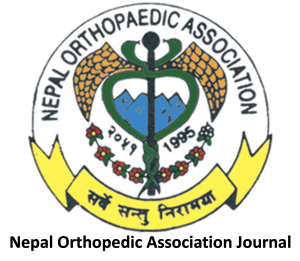A simple but useful technique using artery forceps for reduction of difficult Type III supracondylar fractures in children: A descriptive study
Keywords:
Artery Forceps, Children, Closed Reduction, Humerus, Type III Supracondylar fractureAbstract
Introduction: Closed reduction and percutaneous pinning (CRPP) is a gold standard technique for displaced Gartland type III supracondylar fractures of humerus in children. However, it is sometimes very difficult to have satisfactory closed reduction and may require open reduction which is inherently associated with a number of complications. The aim of our study is to introduce the artery forceps technique for reduction of difficult type III pediatric supracondylar fractures and assess the functional outcomes after surgery.
Method: This was the descriptive analytical study conducted from from April 2021 to March 2023. All patients with Type III Gartland supracondylar fractures which were not reduced successfully after three unsuccessful attempts of closed reduction were included in the study. Study variables included age, sex, mechanism of injury, time to complete the surgery, Baumann’s angle, flexion and extension deficit of elbow and carrying angle (Flynn’s criteria).
Results: Average time to complete the surgical procedure was 20.74±3.78 minutes. Mean Baumann’s angle at the time of removal of K wire was 73.09±1.77 degree. Final functional outcomes three months after surgery based on Flynn’s criteria showed that 25(80.64%) patients had excellent results, 5 (16.13%) patients had good outcomes while 1 (3.23%) patient had fair result.
Conclusion: Artery forceps inserted into the fracture site through a small nick in skin which facilitates to reduce the distal fragment by levering the artery forceps at proximal fragment, is a simple, reliable and very effective technique for reduction of complicated type III supracondylar fracture of humerus in children which otherwise requires open reduction.
Downloads
Downloads
Published
How to Cite
Issue
Section
License

This work is licensed under a Creative Commons Attribution-NonCommercial-NoDerivatives 4.0 International License.
CC BY-NC-ND This license allows reusers to copy and distribute the material in any medium or format in unadapted form only, for noncommercial purposes only, and only so long as attribution is given to the creator.

